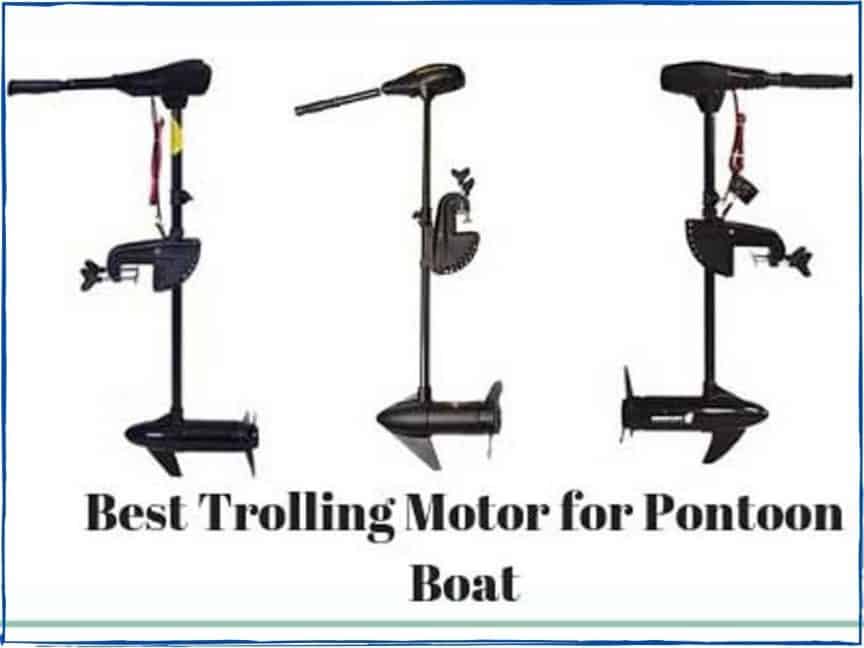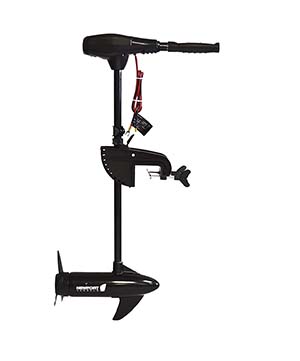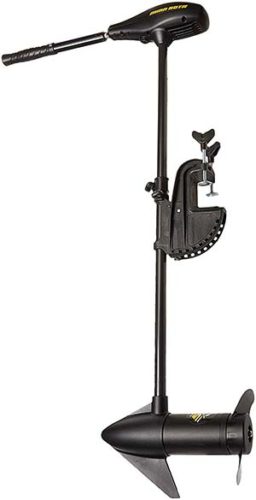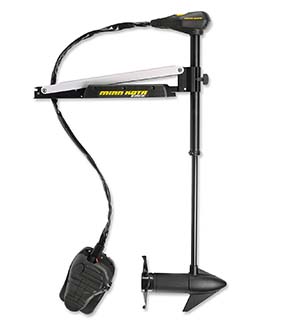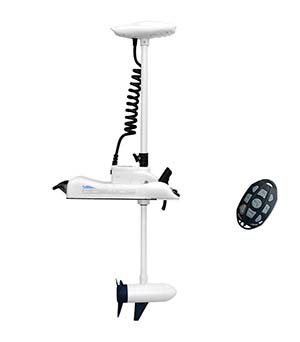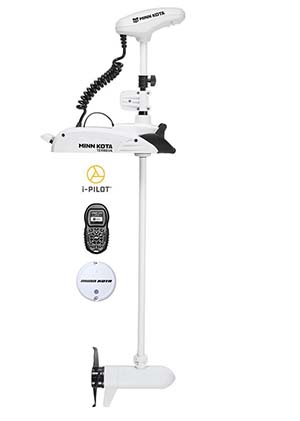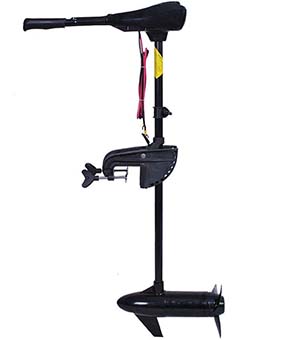Getting out on the water can be fun, but the problem is that your boat might disrupt the water far too much. What is the solution? The best trolling motor for pontoon boat use will surely be easier to handle than anything else.
The problem arises due to the waves a boat might produce and the sounds your electric motor could make. This might be a real hassle when you’re trying to fish. Even more so, it could be tough to try and get bait out when you are bearing lots of noise or movements in the water.
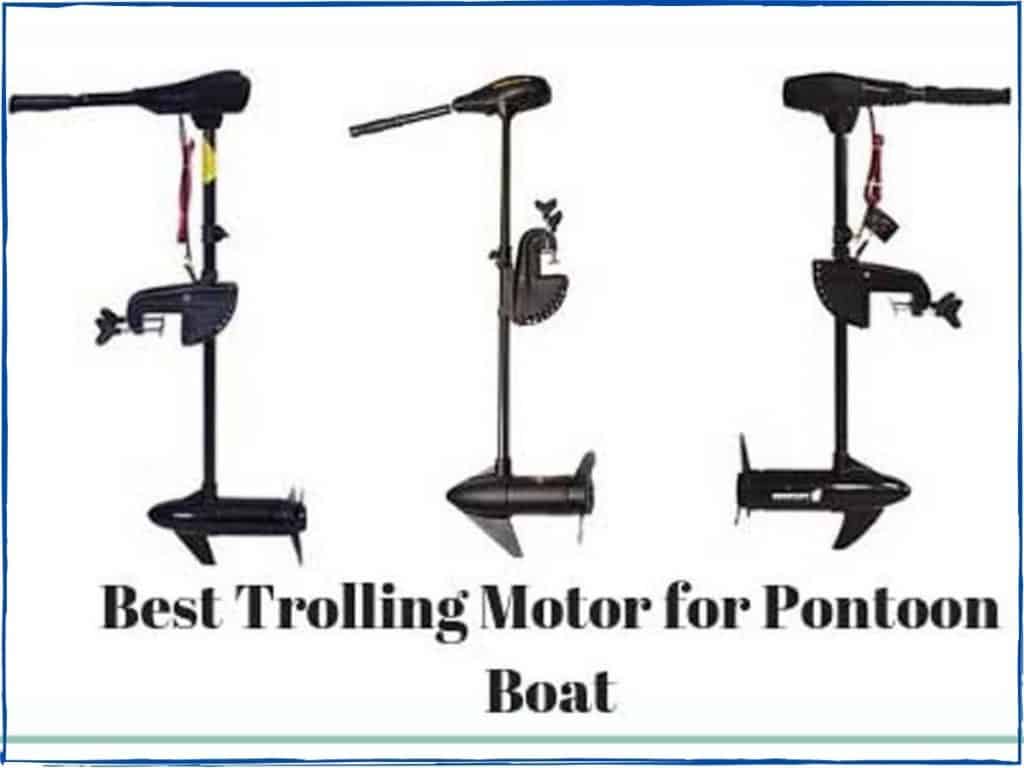
With a trolling motor, it becomes easier for you to find the fish you want to catch. You will also have an easier time with moving forward on the water.
You are going to require a sturdy trolling motor if you want to catch fish or simply enjoy time on a pontoon boat. With a trolling motor, you will get your boat moving out in a gentle fashion. You can even use this when you are trying to lure fish by using a trolling motion with your bait or lure along the side of your boat.
But when finding the best trolling motor for pontoon boat needs, you are surely going to come across some interesting options. This guide should help you understand what types of motors are available for your use and how you can make them all work for you.
This listing of trolling motors for your boating needs includes some appealing options that are suitable for all your pontoon needs. You can use any of these motors for a nice and leisurely day out or just for basic fishing desires. Take a look at what is available and you will be pleasantly surprised.
Comparison Table To Select The Best Trolling Motor For Pontoon Boat
Motor Thrust (Pounds) Shaft Length
In InchesPower Needed
In VoltsView On Amazon
Newport Vessels 8 Speed Electric Trolling Motor 55 30 12 Check Price On Amazon
Minn Kota Endura Max Transom Mount Trolling Motor (55lb) 55/50/45 OR 40 36 OR 42 12 Check Price On Amazon
Minn Kota Edge Bowmount Trolling Motor 70/55/45 36/45/50/52 12,
24 for 70 LBCheck Price On Amazon
Aquos White Haswing Cayman Bow Mount Trolling Motor 55 54 12 Check Price On Amazon
SEAMAX 65 Pound Thrust 12V Trolling Motor 65 40 12 Check Price On Amazon
Minn Kota Riptide 80 ST With I-Pilot (Saltwater Bow-Mount) 80 60 24 Check Price On Amazon
Goplus New 86lbs Freshwater Transom Mounted Motor 86/55/ Or 46 36 12 v,
24 v for 86 lbCheck Price On Amazon
Top Seven Pontoon Boat Trolling Motors With Amazing Features!
Note: Be advised that some of the best trolling motors might not work in all water conditions. Some choices are made with freshwater use in mind and not salt water, for instance.
- Newport Vessels 55 LB 8 Speed Electric Trolling Motor
- Minn Kota Endura Max Transom Mount Trolling Motor (55lb)
- Minn Kota Edge Bowmount Trolling Motor with Latch and Door Bracket
- Aquos White Haswing Cayman Bow Mount Trolling Motor
- SEAMAX 65 Pound Thrust 12V Trolling Motor
- Minn Kota Riptide 80 ST With I-Pilot (Saltwater Bow-Mount)
- Goplus New 86lbs Freshwater Transom Mounted Motor
Newport Vessels 55 LB 8 Speed Electric Trolling Motor
This first motor is a 55-pound thrust option that works well for most fishing needs. The motor is made with stainless steel materials to keep it functional and active even in the toughest conditions. Magnesium and zinc coatings are also added for further protection. The motor runs with five forward speeds and three reverse speeds.
A 30-inch fiberglass shaft is also included. The top includes an ergonomic handle with a five-point battery meter. The design lets you move the motor around in different directions for your steering needs. It is a simple unit that does not take much for you to control or utilize.
Pros
- Fully covered motor is coated to prevent corrosion or damage in saltwater conditions
- The handle makes steering easy to handle
Cons
- Bracket needs careful tightening for it to work
- Can only be mounted onto the transom
Check Availability & Customer Reviews On Amazon
Minn Kota Endura Max Transom Mount Trolling Motor (55lb)
Minnkota is the most popular name in the world of trolling motors. The versatile motors of this brand are always up to the mark. From our point of view, Minn Kota Endura Max is not an exception.
This high-quality motor comes with a 36 or 42 inches shaft which can adjust a pontoon boat. The composite shaft is simply indestructible and one can use it for the lifetime. With the digital maximizer, these motors consume the minimum power and can provide you with the maximum fishing time on a single battery charge.
The power prop of this variable speed motor with extra power works well even in heavy vegetation areas. The transom mount motor comes with a lever lock bracket which is stronger than any traditional bracket because of its special composite material.
Pros
- Digital optimizer helps to control the power and prevents the power loss
- We can set the speed using the variable speed control
- The telescoping handle (six-inch) is simple and provides with easy steering
- Comes with a resistant trolling motor bracket
- Comes with a battery meter that allows you to know the battery life
- Effective power prop
Cons
- Not recommended for saltwater
- According to the State of California, this product can expose us to some chemicals that may be responsible for cancer or reproductive problems.
Check Availability & Customer Reviews On Amazon
Minn Kota Edge Bowmount Trolling Motor with Latch and Door Bracket
This heavier bow-mount motor with the indestructible 52-inch shaft is for small and medium boats. I hope the bow height from the water level will not be an issue. The strong and solid latch & door bracket hold firmly when working with the motor and can be removed without difficulties.
The Minn Kota edge 70 trolling motor comes with a highly responsive foot pedal made of high-impact composite material. The speed control and the on/off system is included in the foot pedal to ensure the proper and efficient use of the motor. To install the foot pedal you need sufficient space which may not be good news for some of us.
The prop maintained the Minn Kota standard and work smoothly through grass or other vegetation. This motor is also available in different thrusts and shaft sizes.
Pros
- The motor has a warranty of two years
- Foot pedal and speed control for better use of the motor
- The bracket-style is strong and easy to handle
- The 52 inches shaft is long enough to be set on the pontoon boats or other boats
- Produces minimum sound
Cons
- Recommended for freshwater and not for saltwater
- The plug is not included in the packet. Can be hooked directly to the battery.
Check Availability & Customer Reviews On Amazon
Aquos White Haswing Cayman Bow Mount Trolling Motor
This lightweight bow mount trolling motor works in both freshwater and saltwater. The 54- inch stainless steel shaft is a nice option for bass fishing boats, pontoon boats, and more boats. The 55 LBS thrust motor works silently and can be nicely used in boats up to 2750 LBS of weight. At the same time, this motor is suggested for the boats up to 18 feet long.
The wireless small remote control can be charged with a simple USB cable when you want. The variable speed makes the motor efficient and low power consuming one. Turning the motor 180 degrees you can get the reverse power. The 3 blade prop of 9.30 inches diameter can rotate 1250 rpm under the water. The motor is easy to carry from the boat to the car. A depth collar is added to keep the motor in right place securely.
Pros
- Two years warranty is great!
- The motor is both for freshwater and saltwater
- The wireless remote control allows you to concentrate more on fishing
- Variable speed control helps to consume less power
- Lightweight and easy to carry
Cons
- It does not have a spot lock
Check Availability & Customer Reviews On Amazon
SEAMAX 65 LB Thrust 12V Trolling Motor
Another choice for pontoon boats can be Seamax 65 pound thrust trolling motor which works smoothly and makes almost no sound. The motor can be mounted at the bow or at the transom as well. The shaft height is 40 inches which is good enough. No problem if you are in a freshwater lake or fishing in saltwater, the motor performs in both. New technology 8-speed controller is made to serve years.
The telescopic tiller handle is great and provides you with easy control and one-hand operation of the motor and the watercraft. The prop is updated with fiberglass reinforced composite material which can push small or medium boats easily. The motor comes with the anti-theft taper-lock transom mount and a voltage meter that helps to monitor in real time.
Seamax made this new motor using modern and standard technology for increased durability and better performance. It is recommended to use the marine deep cycle trolling motor batteries for this unit.
Pros
- Can be used in both freshwater and saltwater
- Can be mounted at the transom or bow
- Easy to install and can be removed without difficulty
- Variable speed controller
- The motor has a warranty for each part differently 1 year to 2 years
Check Availability & Customer Reviews On Amazon
Minn Kota Riptide 80 ST With I-Pilot (Saltwater Bow-Mount)
This powerful saltwater bow-mount motor is an attractive choice for the boaters. The i-pilot is simply the best feature of this motor which permits you to have absolute control of your boat. Use of GPS makes sure to remember the routes and the desired spots for fishing or relaxing. You can connect and control the i-pilot from your Apple or Android mobiles.
The 55 pounds heavy motor (80 LBS thrust) connected to a 60” indestructible shaft will fit almost any kind of boat of right weight. The shaft is made for lifetime use and it is guaranteed for the same time. The famous Weedless Wedge 2 prop is added to the shaft for making your fishing more perfect. The lift-assist design ensures easy stowing. The spot-lock helps to remain in a place with accuracy.
The variable speed trolling motor with digital maximizer consumes the minimum power and let you fish a full day. The battery meter is useful to know the remaining charge of the battery.
With this tough motor designed for saltwater, you can fight even in extreme conditions. Efficiency, smoothness, and silence of the motor are amazing and great.
Pros
- Warranty: 2 years
- Great control by i-pilot and the autopilot works nicely.
- High-quality resistant material
- Almost any kind of boat will work with the shaft of sixty inches
- Minimum power consumption
Cons
- More power (24v) is needed to work with this motor
Check Availability & Customer Reviews On Amazon
Goplus New 86lbs Freshwater Transom Mounted Motor
Look at how this Goplus model works when finding the best trolling motor for pontoon boat needs. This has a 36-inch shaft and uses a nylon bracket to keep the motor mounted while remaining stable. The 86-pound thrust is particularly valuable for larger pontoons as it works carefully and does not produce lots of vibrations, but it also requires two 12-volt batteries for you to make it run properly.
The three blades on the prop keep the motor running smoothly while going through many harsh surfaces with ease. The aluminum body on the motor also keeps the unit clean and comfortable without risking serious harm to the boat. It will not bother the fish either.
This uses a six-inch telescoping handle and five forward speeds plus three reverse speeds. The simple layout provides you with a smooth way forward even when there are difficult weeds or marshes in the way.
Pros
- The motor does not shake or vibrate while in use
- Aluminum head keeps the motor running longer without producing excess heat
- The shaft is long enough for most pontoons to utilize
Cons
- Is not appropriate for saltwater use
- More battery power is required
Check Availability & Customer Reviews On Amazon
An Essential Buying Guide For Pontoon Boat Trolling Motor
Each part of your trolling motor is vital to its success. You have to look for such a motor with several particular standards in mind to help you get more out of your boating activities.
Thrust
You must look at the thrust that comes with your trolling motor when making it work. The best trolling motor for pontoon boat use will come with a strong enough thrust to move the boat forward.
The thrust is measured in pounds and is a review of how much power the motor can handle. A trolling motor needs 2 pounds of thrust for every 100 pounds that the boat weighs. You would have to review the size of your boat alongside what you will add into the boat to get a clear idea of what you can get out of the motor.
The thrust should be powered by a motor that is made with not only the appropriate metal parts but also a sturdy housing. An aluminum or steel motor can work to keep the weight of your unit in check while also resisting most water conditions. The housing itself needs to be made with a sealed off surface that prevents water from getting in the way. The housing should also prevent vibrations from startling the fish in a spot.
Be advised that many of the cheapest or more basic models on the market have smaller thrust totals. These are better suited for smaller boats, but they can work for those who are new to boating and need something that is gentle without being overly hard to use.
Prop
The prop is a feature that propels the pontoon through the water. The power generated by the trolling motor will move the prop along. The prop needs to come with blades that can not only handle the water but also cut their way through the weeds, marshes, grasses and other underwater growths that the boat might move through.
The prop can come with multiple blades. You can find some basic models with just two blades, but some other options come with three blades instead. Also, sometimes the blades might have curves added onto them to make them a little more functional.
Depending on what you use, the prop might be relatively easy for you to take off and clean to your liking. You can choose to get it handled in some way as you see fit, but you will have to watch for how the prop can go back onto your unit at any moment. This ensures that your prop will keep on operating without problems.
Handle
The handle on your trolling motor might not seem all that important, but the truth is that you need the handle to steer the motor around.
When you steer it properly, it becomes easier for the prop to move in a particular direction. This ensures that the boat will move in the spot you want it to head out in. You could even use this to shake the prop around to make it easier for the boat to drag and shake your bait or lure if you are fishing.
The handle can come with a telescoping body or a series of grooves depending on what you use. But whatever you choose to have, you must look at how well this might work.
Securing Feature
The way how your trolling motor is to be secured deserves to be reviewed. The motor should be secured at the middle with a clamp or other fastener to keep the motor from shaking. You would have to tighten this feature to ensure the motor stays in its place.
A series of levers may be used to secure the trolling motor in its mounting position. These would have to be aligned evenly while keeping the body of the motor perpendicular to the boat itself. It has to move down into the water perfectly and evenly for this to work out right.
You might have to check on how secure your motor is on occasion after you get it installed. The motor might start to slip out of its position after a while. Check the security features every now and then to see how well it is working and that you have a good sense of control over whatever you wish to work with.
Mounting Position
A majority of trolling motors for pontoon boat use will have to go onto the transom. This is the back part of the boat. Also, the motor would have to go into the middle part of the transom while being carefully aligned to ensure that power would move evenly from the motor.
There are some models out there that can be handled on the bow or even on a larger engine. But a majority of today’s trolling motors are designed for use on the transom above all other places. Be aware of this when you are getting your setup mounted properly enough so you have enough control over what you are getting off of it.
Regardless of how the boat works, you would have to review the transom, in particular, to see how it is laid out. You might have to move things around on the back end of the boat just to make the transom a little more accessible and ready for use. The rules involved in getting your boat organized right will vary based on what you can handle.
Shaft
The shaft on your trolling motor refers to the material that goes from the edge of your pontoon to the motor under the water. You need a shaft that is long enough to go through the water.
You can figure out the shaft that you want to use by measuring the top of the transom, or back part of your pontoon, to the waterline. Your shaft needs to be around 30 inches in length if the distance from the transom to the waterline is 10 inches or less. Meanwhile, you can move up to 36 inches if the distance between those two parts is closer to 16 inches.
Some models come with special adjustment features where you can move the shaft up or down. This could work if you plan on moving the transom motor from one boat to another.
Be aware of what the shaft is made out of as well. A shaft can be made with one of the various different kinds of compounds.
It can be made with fiberglass to create a strong body that will not wear out or weaken. The key is for the shaft to be strong enough to go through most water conditions while keeping vibrations from being a problem.
Voltage
The pontoon boat trolling motor use will link to a proper marine battery. The voltage readout for your motor refers to the battery power you would need to get the motor to run right. In most cases, you will need a 12-volt marine battery. You can use the wires that come with your motor to link to the battery.
Larger motors that have a greater thrust total will require more voltage. You might need to use a 24-volt battery or two 12-volt batteries to get your motor to start working in that case.
You would have to look at the wires that come with your motor to see how well they link to a battery. The trolling motor battery would clearly have to be placed close enough to the motor itself to make the connection a little easier to handle.
But no matter what you use, you would have to watch carefully for how well the wires on your setup work and that you are not getting into any problems with what you have.
Speeds
The number of speeds that your motor can handle should be explored carefully. Most of today’s trolling motors use five forward speeds and three reverse speeds. These intervals are good enough for helping you to move the boat forward and backward although the speed you will travel at is not going to be all that great.
In most cases, you will not get your boat to go any faster than 10 miles per hour. That is perfectly fine though, what with a trolling motor designed to simply handle a gentle amount of speed and force without overdoing it in some fashion.
Water Condition
Take a look at the conditions of the water that you will be getting into when using your motor. A trolling motor should come with a good body that can handle fresh and saltwater alike.
But be advised that some models are not good with salt water. Check on the specifications of any trolling motor you want to get to see how well your motor can handle salt water.
Warranty
The warranty on your trolling motor might not be something that you will think about, but it deserves to be explored for how well it might work. The warranty on your trolling motor should work for a few years on average.
The warranty will only cover things that you do that the manufacturer recommends you do with the motor. You would end up voiding the warranty if you try to modify the motor or use it for purposes outside of whatever it is the motor was supposed to be used for.
Frequently Asked Questions
The following is a listing of sensible questions that should be considered when finding a quality trolling motor. The best point to consider though is to look at the size of your boat versus the particular motor you will use.
How much noise will a motor make?
The noise produced by the motor should be negligible when it is built properly. The housing should conceal the metal parts well enough to keep the sounds of the motor from getting out and being too bothersome to anyone.
This is especially important for the fish that you want to catch as you do not want anything overly loud that might bother the fish.
Is the prop going to cause any disruptions in the water?
The prop will move well enough to generate enough force to move your boat, but it will not cause any significant waves or other changes. This is ideal as the fish you want to find will not feel bothered or threatened by your boat or anything else you are using.
How fast will your boat go with one of these motors?
A typical trolling motor will go from around 4 to 10 miles per hour on average. This is slow enough to allow the water to stay relatively calm and to also allow any bait or lures you attach onto the back to move at a reasonable pace.
Would you have to sharpen the blades on your prop?
You should not have to sharpen the blades as they will work well enough if they have enough thrust in them to cut through the grasses or other surfaces you are trying to move through.
But even so, you should at least watch for how well the blades are laid out and that they are not cracking apart or otherwise wearing out prematurely. By reviewing the blades on occasion, you will get a good idea of how well the prop is working.
How long can a battery work for?
A battery can run for a few hours at a time before it has to be recharged. Be aware of how you use your trolling motor in any situation. You might have to slow down for a while to keep the battery from wearing out quickly.
Can a trolling motor really be a full replacement for traditional oars?
Although a trolling motor can work well for your demands, it helps to at least get some oars on board your pontoon to be safe. This is so you can get enough propulsion going in the event that the battery linked to your motor dies out.
Of course, it might help to just get a few spare marine batteries on board to be safe, but having oars on hand at least helps you out in the event that the worst-case scenario comes about and nothing is working at all.
Can a trolling motor that is designed for use on an inflatable boat also work on a pontoon?
There is no reason why a trolling motor for one type of boat cannot work on another kind. The key is that the motor should be powerful enough to propel a different kind of boat while working without any added disruptions.
But no matter what you use, you must see that the mounting materials used to keep your motor in place are designed carefully and with a proper layout. You might need to put in an extra effort to try and get the motor mounted carefully enough on your surface.
Will a trolling motor add a large amount of weight to your boat?
Your trolling motor should only be around 20 to 40 pounds in weight. It should be just fine for a pontoon.
Can a trolling motor work in intense water conditions?
Not all trolling motors can handle tough waves or intense currents. You might have to get a larger electric engine ready on your pontoon if you are going to get something to move in tough water conditions. Our Motorguide Xi5 review could help you as it is a versatile and strong motor.
How long does it take to actually get one of these motors installed onto a boat?
It should not really take all that much time to get a trolling motor installed. You would have to simply adjust the length of the shaft, attach the motor setup to the transom, secure it properly, and then get the electric wires to link to your marine battery. This should only take a few moments for you to complete.
But as you do this, before mounting a trolling motor you must also look at how well your boat is laid out and that you have the right materials on hand for the task.
The materials should all be included with the motor. That is, you should not have to get anything extra on your end outside of the battery to make the motor work.
But regardless of what you use, you should check on the instruction manual for your motor. This is to get a clear idea of what you can get out of a motor and how it will work with ease in any situation.
Conclusion
The best trolling motor for pontoon boat use will always be one that fits your demands nicely and is easy to apply. Be aware of how your pontoon is laid out and look at how you will use your motor in some situations. Knowing what you can get out of your motor can make a real difference when you get a good plan going for making it all work to your liking.
You must have a unit that is strong enough for your use and will not be overly complicated or hard to utilize. It must also handle the water conditions that you plan on getting out in. Be sure to see what you can use when finding a quality trolling motor that you know will be right for your use and provide you with the help you desire to get out there on the water.

